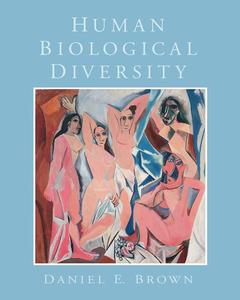Description
Human Biological Diversity
Author: Brown Daniel E.
Language: English
Keywords
HIGH ALTITUDE HYPOXIA; Pe Rc; allele; DNA Molecule; frequencies; Mitochondrial DNA; american; Nuclear DNA; journal; Air Pollution; biology; DNA Chain; high; Young Man; altitude; Human Population Biology; hypoxia; Allele Frequencies; variation; Mobile DNA Element; restriction; Human Biological Diversity; Life Expectancy; Anorexia Nervosa; Human Biologists; Life Span; Life Table; Dry Heat; Homo Sapiens; IQ Test; Homo ERECTUS; Human Biological Variability; Energy Source; DNA Allele; Genotypic Traits
Publication date: 06-2017
· 20.3x25.4 cm · Hardback
Approximative price 53.96 €
Subject to availability at the publisher.
Add to cartPublication date: 11-2009
360 p. · 20.3x25.4 cm · Paperback
Description
/li>Contents
/li>Readership
/li>Biography
/li>
Chapter 1: Introduction
Chapter Summary
Chapter 2: Concepts of Evolution
A Brief History of Evolutionary Ideas
Ideas About Time
Western Ideas
Contemporary Western Views of Time
Some Non-Western Concepts of Time
The Great Chain of Being
Scientific Approaches to Evolution:
Lamarck's Theory of Evolution
Darwin's Theory of Evolution
Types of Evidence for Evolution
Creationists Vs. Evolutionists
Adaptation
Concealment
Mimicry
A Human Example: High Altitude Adaptation in Tibet
Imperfect Adaptations
Paleontology
Biogeography
Comparative Anatomy
Homologous Vs. Analogous Structures
Vestigial Structures
Comparative Embryology
Artificial Selection
Other Evidence for Evolution
Chapter Summary
Chapter 3: Genetics and Microevolution
The Chemical Basis of Life
Proteins
Protein Structure
Protein Function
Nucleic Acids
DNA Structure
DNA function
Duplication of DNA
Direction of Protein Synthesis
Messenger RNA
Ribosomes
Transfer RNA
Genetics
Sexual Reproduction
Mitosis
Meiosis
Mendelian Genetics
Alleles Vs. Loci
Principle of Dominance
Principle of Segregation
Principle of Independent Assortment
Genotype and Phenotype
Consequences of Mendel's Principles
Sex Chromosomes
Complex Traits
Mutations
Microevolution
Introduction to Population Genetics
Frequencies
Hardy-Weinberg Equilibrium
Forces of Evolution
Selection
Types of Selection
Mutation
Genetic Load
Migration and Gene Flow
Genetic Drift
Assortative Mating
The Synthetic Theory of Evolution
Chapter Summary
Chapter 4: Molecular Genetics, Genomics and Human Genetics
A Closer Look at Chromosomes
Characteristics of Chromosomes
Chromosome Structure
Chromosome Structure and Function
Regulatory Regions of DNA
Special Features on Chromosomes
Other Types of Repeated DNA Sequences
Chromosome Mapping
Linkage Maps
Linkage Maps of the X Chromosome
Mapping By Means of RFLPs
Microsatellites in Mapping
DNA Sequencing
Polymerase Chain Reaction
Epigenetics
Methylation of DNA
Imprinting
In Utero Effects
Extrachomosomal Genetics
RNA Processing
Introns and Exons
Other mRNA Processing
Why the Complexity?
When Things Go Wrong
Mitochondrial DNA
Origins of Mitochondria
Mitochondrial DNA
Chloroplast DNA
Tracing Genetic Variability and Function
Genetic Variability
Single Nucleotide Polymorphisms (SNPs)
Oligonucleotide Hybridization Analysis
DNA Chips
Other Allele Differences
Understanding Gene Function
Gene Inactivation
RNA Interference
Gene Overexpression
A Brief Look at Quantitative Genetics
Basis of Quantitative Genetics
Heritability
Human Genetics and the Human Genome
Family Studies in Human Genetics
Twin Studies
Adoption Studies
The Human Genome
The Human Genome Project
The Next Step?
Chapter Summary
Chapter 5: Macroevolution and Speciation
Taxonomy
Species and Speciation
Species
Sibling Species and ASemispecies@
Speciation
Adaptive Radiation
Rapid Div




